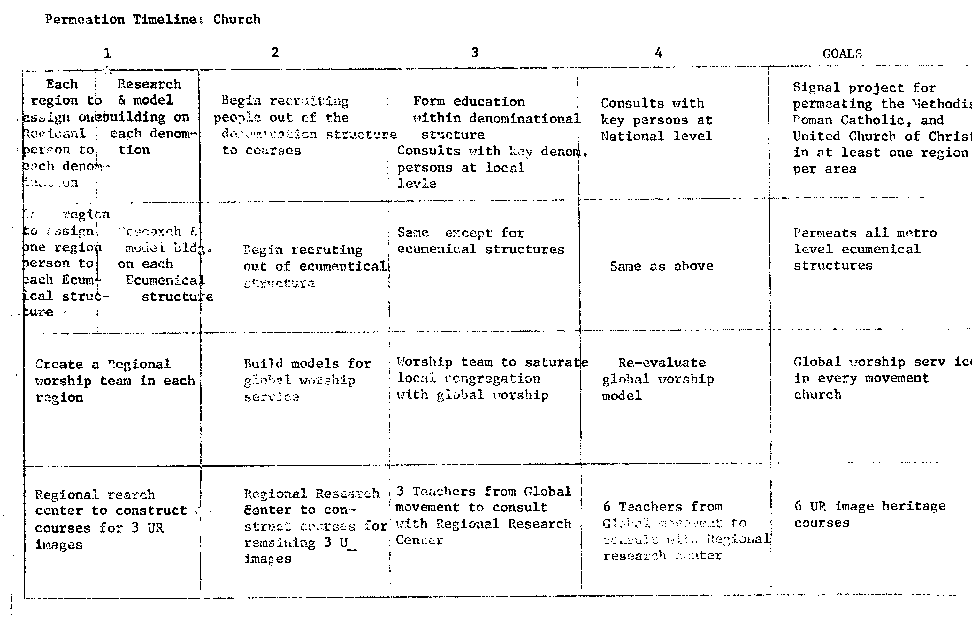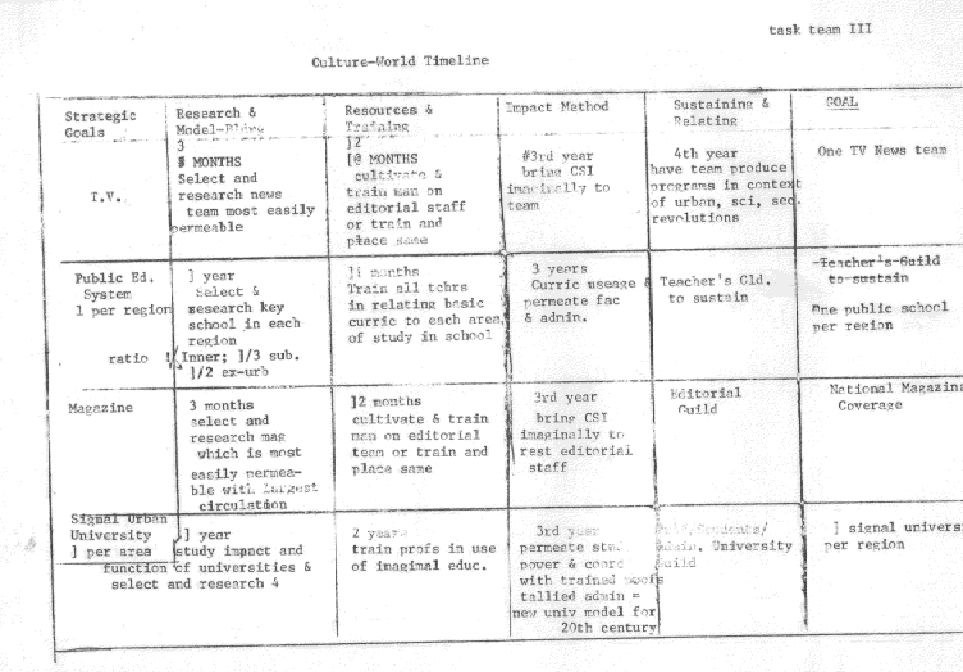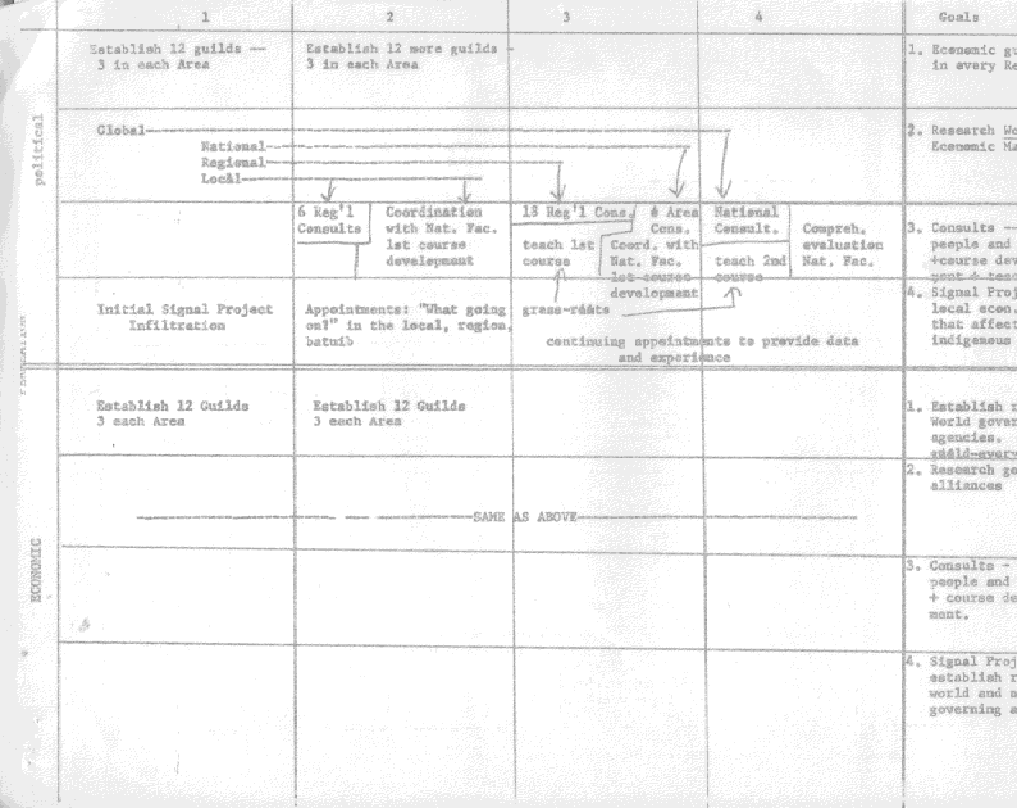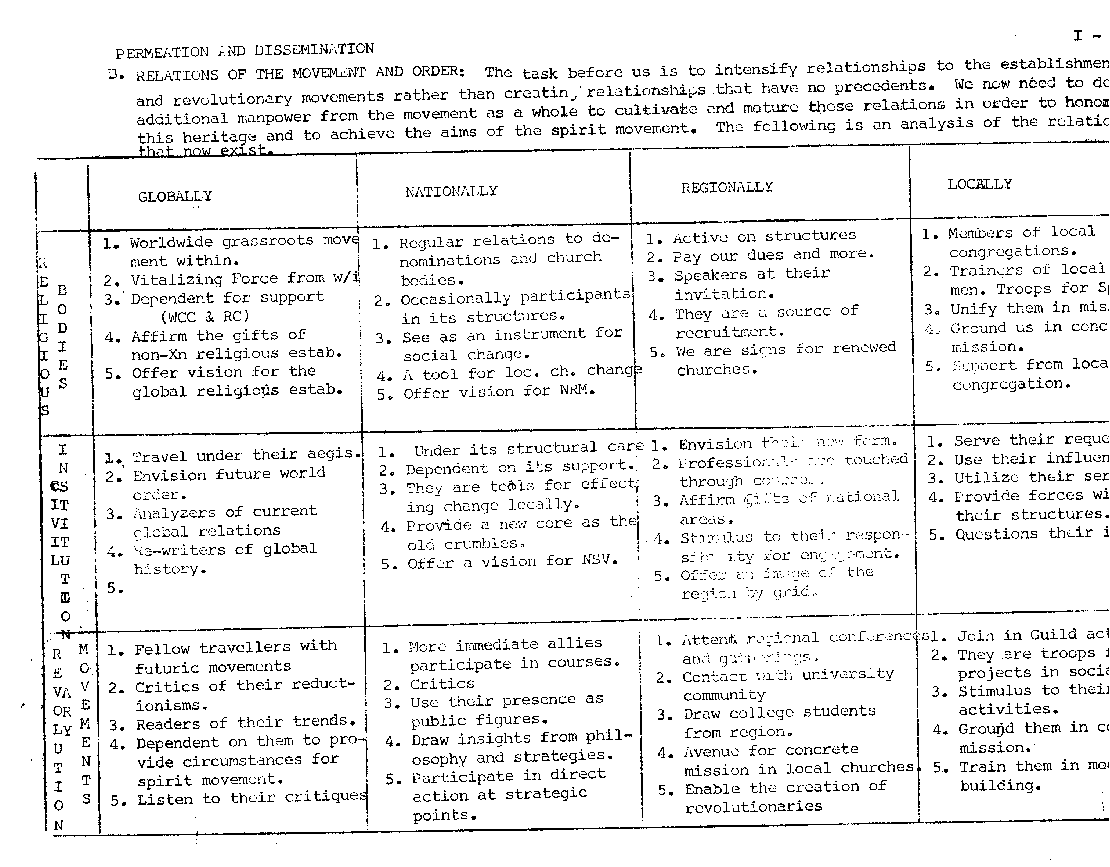 C. TACTICS
C. TACTICS
I. Introduction: Thesis
A. Goals
B. Relations
C. Strategies
II. Primary Constructs
A. Consultations
B. Guilds
III. Locus: Religious Establishment
IV. Locus: Civil Establishment
V. Locus: Revolutionary Movements
VI. Conclusion
A. Timelines
B. Funds
C. Staff
Order Council
August 1968
Research Team IV
PERMEATION AND DISSEMINATION
I. Thesis
Introduction: the demand
upon the Spirit Movement at this point in history is to move .into
the structures of the world in a more self-conscious fashion than
ever before. 'While we have spent sixteen years in developing
the theoretics of our selfunderstanding and its implications
for practical engagement, it is now the time to be the style of
life called for in our times. While local church cadres have begun
to emerge, their efforts are stagnated in part by virtue of internal
needs but also because of objective blocks erected from the fearful
and uninformed members of existing structures. As the people of
God embodied in the selfconscious Church, it is our task
to be the catalytic force that unblocks the avenues of change
for a given moment in time.
A. Goals: The task before us in the next four years
is to intensify our relationships to the religious and civil establishment
as they are being met by demands from various revolutionary movements.
Our general aim is to turn the civil institutions into an entirely
new social vehicle and the religious bodies into a new religious
mode. More specifically we are out to permeate and disseminate
the Spirit Movement into social and religious structures.
To reliance the flood of antiquated metaphors that
pour out of the establishment with new human metaphors that enable
new humanness.
To presence the possibility of men creating history
by being a sign of loyalty to structures while revolutionizing
them.
To obtain permission from the establishment for grassroot
change to take place and to be accelerated with the understanding
that only grassroots revolution will finally bend history.
To actualize the change that has already begun and
will continue to take place within all levels of structures.
To utilize resources of the world created yesterday
in order to create the world of tomorrow.
To affect changes in the superstructures of the western
world as a sign to the Third World that repentance has taken place,
 C. TACTICS
C. TACTICS
INTRODUCTION: The key tactics of the Movement are
1) dissemination, 2) penetration and 3) infiltration. Each of
these tactics serve a specific function' pivot upon a locus of
change and employ various enabling tools. Preparation for the
implementation of these tactics involves depth research and analysis,
including initial data gathering, geographic gridding and designing
specific goals, tactics and timelines.
Dissemination: Dissemination
is required to perpetuate the movement. Thus' its' primary function
is to increase the momentum of the movement in order to change
the civil and religious establishment. The locus of energy is
the geographically defined grass roots level. Extensive use of
mass media, speaking engagements, conferences and mailings are
tools for enabling dissemination for the sake of recruitment and
involvement in permeation.
Permeation: The primary
function of permeation is that of sustaining the momentum of the
Movement by enabling people within the establishment to perpetuate
change, Here the locus is the establishment hierarchy, utilizing
the tools of special and regular courses, consultations and special
services (advisory roles' conference center' etc.).
Infiltration: While the
functions of both dissemination and permeation are primarily concerned
with the people within civil and religious structures, the function
of infiltration is to effect change in the structures themselves,
Thus, infiltration perpetuates and sustains the movement by influence,
data gathering and direct decision making in the locus of establishment
structures. Critical tools are the placement of movement people
in positions within the establishment the cultivation of key contacts'
attendance at various gatherings and being a sign of possibility.
A. Consultations
Introduction: The primary tool for permeation of
the civil and religious establishment is the consultation in that
it enables us to deal with a controlled and structured situation
in which a high degree of intentionality can be brought to bear.
Types: In setting up priorities and various kinds
of consultations, it is necessary to select and order the types,
One type is categorized as issueoriented and is organized
around a particular issue pulling in participants from across
the society or at least the various portions of society and the
globe direct`y involved. Another type would be for professional
groups and would include any particular occupational group which
could play a key role in impacting the establishment. Consultations
will be for particular institutions that are intimately related
to the established structures while others deal with social institutions
geared to dealing with gaps and weaknesses in the social structures.
To set out and begin to break open issues and problems in geographic
areas some consultations will be geographically based. Finally
consultations will be held to deal with varying manifestations
of the national and international spirit movement.
Recruitment: Once there is clarity on the type of
consultation, consideration must be given to the kind of participants
desired and the means of recruit them. The first task in deciding
on which participants is to set a context by use or a comprehensive
grid. This grid should also point to the optimum number desired
to accomplish the desired goals. In rating selection's inclusiveness
is a primary factor utilizing a great variety and types of related
personnel although in particular cases the selections wil1 be
intentionally limited in scope. In addition to this most every
consultation will strive to include signal people for strategic
or pragmatic reasons. Recruitment of these persons will be through
mass mailings for the comprehensive list, follow up telephone
calls, some personal letters and special letter, mailings and
interviews for signal people. Records on the consultees will be
developed indicating special gifts and skills as well as potentiality
as colleagues. While the specific task of recruitment is carried
out, background cultivation will be created utilizing tracts projecting
our image as consultants, publications with data of our experience
and research, stationery and brochures with the names of respectable
colleagues and a story about the finesse and grandeur of our consultations.
Format and Location: The basic questions of when, where and how must be answered to successfully carry out a consultation. Generally speaking, consultations are set within the quarter structure of the calendar year although in special cases optimum times of scheduling are related to the availability of the kind of participant desired. The time format for each consultation is set to allow for comprehensive coverage as well as the completion of a relevant document or some other comparable results. The length of consultations will vary from brief 4 hour public relations or data gathering type consultations through reach-out sessions, which will be the most common to extensive onetothreeweek sessions for depth accomplishment. In deciding on a location the geographical context should be where possible related to the context of the consultation. Housing is to be in the immediate area of the conference facility which must provide adequate space to unite the entire group including meals, smaller rooms are also necessary for dividing relatively larger groups into task units. Meals should be available in both smaller and larger rooms. The format will have a rhythm of lectures, workshops, and writing sessions with a symbolic life permeated through the meals. Methodologies will be similar to those used in E.I. courses with greater informality in shorter sessions. The data, public relations consultations are generally informally formatted; the issue, professional and social group types require more lectures; and the institutional, geographic and movemental types require more workshop sessions to create the content. Materials needed are similar to regular courses in addition to
printing, mimeographing and book purchasing systems
for background information. In addition to this, typewriters and
audio visual equipment would be helpful.
Research and Follow Up: In order to maintain integrity
in the consultations, considerable research, evaluation, pulling
together, and presentation of the results must take place. The
theoretical basis of most consultations will be the RS and CS
curricula with adjustment to particular situations requiring additional
research. search is also needed for the selection of personnel
for determining points of unclarity to be answered through the
consultation. The followup result of the consultation is
a publication in the form of a statement of the results or a documentary
statement drawing the results together. The second result is an
evaluation from both the participants and the staff for future
use. Finally results are present in the form of contacts in both
the civil and religious establishment that would be useful in
furthering the transformation of these structures.
II. GUILDS
Introduction The decay
of the civil and ecclesiastical structures of society demands
the presence of catalytic guild structure to hammer out the operationa1
models and strategems for post modern society and mobilize various
levels of the human community to direct structural action in relation
to the manifold complexities of this task In response to this
demand the Guild performs a three fold function: It is an action
force designed to bring about change at the localis, globalis
and regionalis dimension of society. It is an action tool designed
to attack the fundamenta1 problem in the economic, politica1 and
cultural structures It is an action structure in relation to the
ecclesiastical and civil establishments to bring into being the
New Religious Mode and the .New Social Vehicle. It is related
to the consultation in so far .is it utilizes this tool its method
of catalysis and planning but differs in that ii: is an ongoing,
structure that relates to the solution of a particular problem
It is related to the movement, its fundamenta1 tool for attaching
basic structura1 problems in society. It is related to the ecclesiastical
and civil establishment in that those establishment people who
have participated in consultations will provide resources, personnel
and leadership for the guild. Finally as we are concerned with
the permeation of the civil and ecclesiastica1 structures at the
level beyond the localis; we will be speaking to the relation
of the guild to the localis and in particular to the regionalis.
In order to instigate and enable the occurrence of the Third Continental
Congress in 1976 in the North America regionalis the creation
of the guild structure at this level is nothing less than crucial
to accomplishing this limited end.
Guild Levels: Guild organization, structure and function
will be similar at the Globalis, Localis and Regional levels but
with specialized capacities at each level In the Globalis the
function of any particular guild will be primarily to analyze
and interpret new data on worldwide social problems to unify
planning, and give new direction to future strategizing and to
hold the movement accountable for participation in the common
model at the localis level. The Localis will be the actual arenas
of attacking the crucial social problems in the geosocio
units with involvement of citizens of the community, following
priorities established in relation to the whole global scope of
the problems. Regionalis guilds will be the locus for coordination
and distribution of needed technological, natural and human resources
to any Localis for enabling effective attack on a specific problem.
Action Phases: There are three action phases in the
function of the guild at the globalis and regionalis levels. First,
initial issues clarified, secondly, model construction, and thirdly,
direct action. In the first phase of issue clarification, relating
for example to the Continental Congress of 1976 the analysis of
the economicpolitical structure of North America in relation
to the globalis and the localis would be necessary. Guilds would
be established inthis initial phase to get clarity on the
manifold human and structural problem6 and prepare a broad outline
for' the second phased The creation of concrete social models'
plans for permeation of the civil and religious establishments,
the dissemination of e images and models for the act of social
repentance' the creation of operational strategies and tactics
concretized on a time plan are the essential elements in the second
phase. The third phase of direct action would take three forms:
the lobby, mass action, and consolidation (or follow up). The
lobby would be an action structure directly related to influencing
the political establishment at the various levels of the regionalis.
Mass action could be mobilized in relation to the need for direct
action (mass letter writing, phone calls. demonstrations. etc.)
when indicated by the lobby. Consolidation of gains by direct
action would be the third form or follow up action.
Guild Operation: Arrangements for guild operation would include announcement of meetings to deal with specific issues in the political, economic or cultural dimensions. .l regular schedule of meetings would be established on a monthly to semiannual basis, depending on the guild level, Globalis' Regionalis or Localis' adequate facilities would be provided for housing1 food service and meeting rooms at a centrally located conference center, perhaps the Regionalis House itself. Representatives would be invited from comparable guilds at the Localis levels, Transportation information would be provided and equitable financial subsidy arranged. Methodology of procedure would include problem analysis workshops and concrete model building with decision making by consensus. Procedures would include reporting' accountability and future planning with assignments of specific responsibility for particular tasks.
Conclusion: Many problems are evident in establishing
guilds at levels above the localis. It is clear' that there will
be no significant action and structural reformulation unless a
network of cadres is built at the level of the localis, Without
troops at the grass roots capable of being mobilized, premature
action at the level of the regionalis by a guild could be disastrous.
The development of the localis manifold times over again across
the country and the world is the key to structural revolution.
Timing is of critical importance. Certain cautions are necessary
in the operation of the guild. Without a comprehensive view and
a global plan, absorption of the guild by the structure is inevitable'
resulting in disrelatedness and total lack of effectiveness. Or
again, the tendency toward bureaucracy can be avoided only through
grass roots participation by the localis in the broader levels
of guild action in the Regionalis. Finally, the imperative upon
us if we are to bring into being the New Social Vehicle and the
New Religious Mode and as an initial step The Continental Congress
of 1976 for the North .American Regionalis' is to immediately
lay the foundation for the forming of the guild task force units
in the North American Regionalis.
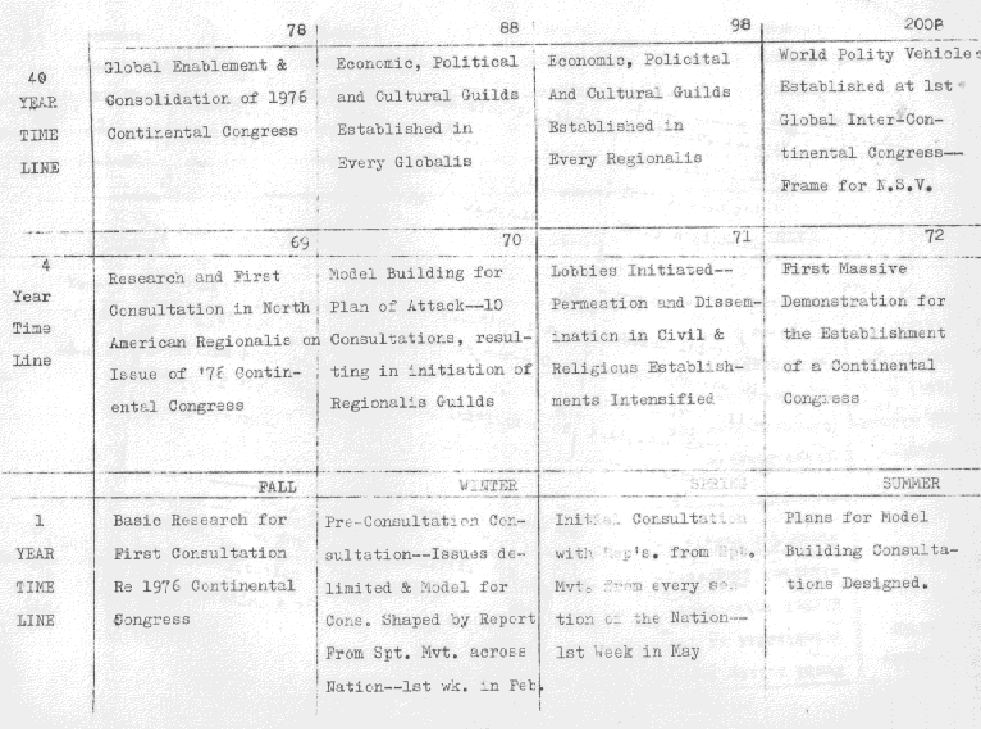 Locus: Established Church
Locus: Established Church
A. Research and Analysis In order to seriously impact the historical religious establishment intentional structures for research and analysis must be created. Initially a careful analysis must be made of the existing established church as to organization, key personnel, geographical concentration of denominations, nonwestern religions, and Roman Catholics, bureaucratic arrangements and headquarter locations. Secondly, an analysis of staff and movement personnel should be created which would show present relationships to church establishment and potential for future relationship. The analytic models would indicate areas for which specific research projects would be necessary. The research productivity plus the normal flow of data from other existing programs would be fed into the analysis structure in order to keep the penetration of the church establishment on a current edge.
B. Presence and Public Relations Possibly the key to the intentional penetration of the church establishment is the image from which we operate and by which the establishment recognizes our presence. It is crucial that the establishment recognizes the Institute and movement as totally dedicated to the life and future of the church. The image of "servant" should be intentionally created and cultivated not only by our own self talk but also through our encounter with the establishment. In our normal public relations work plus the intentional contacts with establishment "friends" the image of "servant" would be our guiding principle. The creation of such an image would increase the possibilities for our participation in establishment functions, conferences, and councils as well as increase the possibility of our being used as a resource center.
C. Training and Consultation Since education has been one of the Institutes major focuses it is logical that a major strategy would be training of establishment personnel. The training of establishment personnel could be en several levels and be focused at a given point within the established structures. Personnel could be recruited for the regular curriculum courses, special courses could be created for establishment officers of one area (such as Mission Board secretaries from several denominations) or courses for entire staffs from a particular department or denomination. Another point of focus would be consultations or the consultative function of education. A separate section of the document is given to a detailed description of this strategic vehicle. The role of the conference center as a tool of penetration should not be overlooked, The environmental function of the conference center in the educational and consultative focus is crucial. The environmental impact plus, the encounter with the life of a religious order is significant in creating the necessary image and grounding for the establishment in the Institutes decision to be dedicated churchmen.
D. Publications and media
An obvious, strategic channel of penetration into the church establishment is the area of mass media and particularly printed media. To this point the thrust has been primarily through our publication and periodicals, This is still a valuable avenue, but it must be intensified and brought to a point of expertise. The present publication should be styled and written to broaden their appeal from a relative narrow base of primarily grads to a wider field of total denominational magnitude. In addition to our own publication use should be made of the ever increasing number of competent theological and church oriented publications. A portion of the creative writing power of staff should be directed toward impacting denominational and theological journals with first role lead articles reflecting and articulating the current edge struggle of the church establishment. The most remote area of penetration is the established structure of other major religious expressions. It might be that publications would be the logical and initial step in entering the area of "world religions,'. Many journals on Christian dialogue with other faiths are available to be used as a vehicle for penetration of these establishments.
E. Structural relations and service
The push for penetration of the church establishment is to have the methodologies and insights of the movement to be made visible and practically effective on the grass roots level of the church. This means the relationship would be of a structural and resource nature. In principle resources of the movement would be at the absolute obedient call of the established church at whatever level and that openness be maintained to the possibility of assigning staff, at the request of the establishment, to existing structures to increase the penetration to a depth level
IV. Civil Establishment
A. Enablement
Background research is necessary to build a grid of the civil establishment its centers of power, decision making processes, operating images ant style, its key leadership ant its edge leadership. On this basis a training program can be devised to equip our permeation forces with the necessary data and methodologies for effective penetration.
B. Contacts
The first strategy for permeation is to make key contacts in the civil establishment. To do this we must mark priorities among the various civil establishments set criteria for significant contacts within each establishment, grid our present contacts and then develop an effective methodology. The methodology for making contacts needs to focus on how to make an effective initial encounter through whatever media from personal inter views to TVradio. Once contact has been made then methodologies for continuing the relationship need to emerge ea. through calls favors mailings to cultivate the openness and availability of the persons or structures.
C. Services
A second strategy is to provide services that are important to the civil establishment, e.g. consultations, research, model building problem solving, staff training and political support. Criteria for which services how much and for whom must be established to keep our service to the establishment under strict control or our goals and time lines.
D. Placement
A third strategy for permeation of the Civil establishment is to place order/movement personnel in strategic positions. Which establishments, which positions within those establishments qualifications for order/movement placement in the structures the necessary briefing/training and the duration of the particular placement need to be worked out. The function of placement must be determined for each establishment; e.g. to gather data influence certain policies, or take control.
REVOLUTIONARY MOVEMENTS
Research: To penetrate and capture the force of revolutionary movements, research is needed in three areas. Basic data must be gathered to identify leaders, the thrust of the movement, and the structure of the organization. It is also useful to examine the hero figures of the group and the type of role they play. The data is gestalted and placed on structural charts indicating organization and decisionmaking process both in method of and implementation. A study of the history of the movement as it writes its own and a study of the stated goals is also necessary.
Training: With the data in hand, training program is developed to influence the direction of the movement. One of the most effective training tools is the consultations. Centered either on the group itself or on an issue central to the group, it is a means of directing the movement through the development of its own wisdom to its fullest possible extent. Special courses can also be used with certain groups. Courses on new politics, new economics, or social change, for instance, offer a chance for direct imaginal education of movement members. Many of the movement people, because they are genuinely concerned with and involved in the civilizing process are eager to receive tools for their task. For this reason, direct recruitment to our curriculum is valuable. The longer programs where several courses are offered are particularly helpful especially the sojourner program or the 3060 day seminary program. It is also necessary to take the courses to the movement, coinciding them with conferences, or rallies or holding them at campus centers.
Participation: of a noncourse nature at movement conferences is a P.R. tool and a source of research material. Guest lecturing males a more powerful impact. Conferences held at an Ecumenical Institute facility can be to some extent also helpful P.R. Movement demonstrations entail varying degrees of participation from providing demonstrators to assisting in the nittygritty of the demonstration; organization, housing, or transportation. Special kinds of participation in a movement's thrust is through contributions to journals, speaking engagements as requested, assistance in access to civil or church leadership and a sharing of methodological wisdom in movement theoretics and practics.
Direction: Many revolutionary movements can be and need to be given concrete direction to their vision. This requires the development of a platform for the New World and an actual construct for the issue or area of each specific movement, including goals strategies and tactics. It is valuable to have a format for the educated man of the 21st Century. The tools used to effect the direction of a movement are primarily symbolic. Tracts and art forms, music and rites can all imaginally educate prior to permission or request for help from the leadership. Direct infiltration of the movement will allow the presentation of charts, time lines, curriculum and methodologies. Then leadership training becomes possible.
Recruitment: Finally, recruitment of the members
of revolutionary movements directly to our courses enables many
of them to participate in the selfconscious spirit movement.
Members of youth movements and their leadership can particularly
benefit from more comprehensive participation in the civilizing
process. From our own viewpoint international students and leaders
are crucial All of these require the usual various recruitment
methods to enlist them in the ongoing curriculum.
40 YEAR TIME LINE FOR PERMEATION AND DISSEMATION
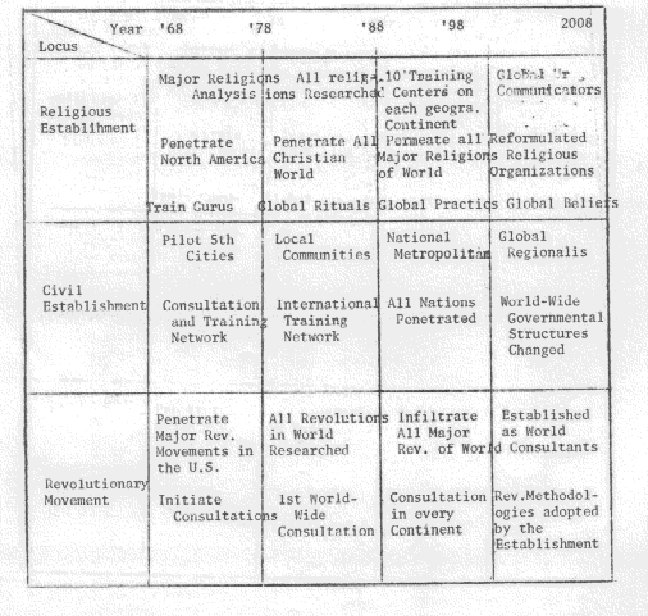
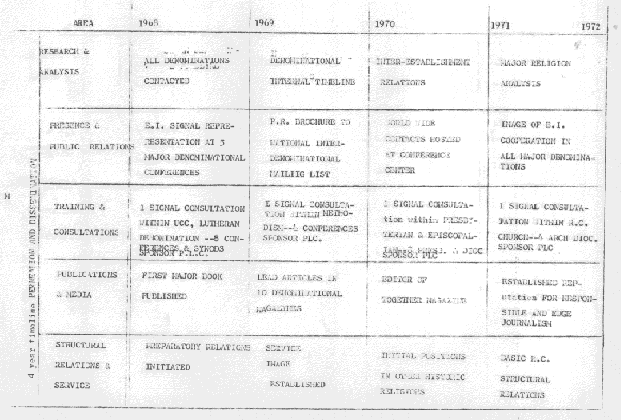
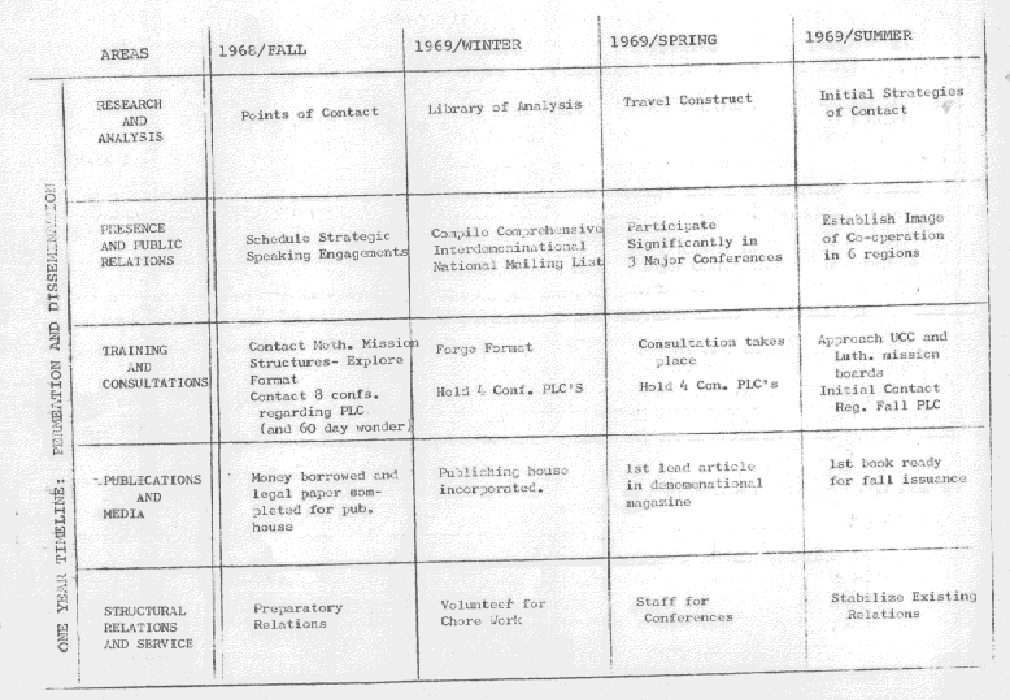
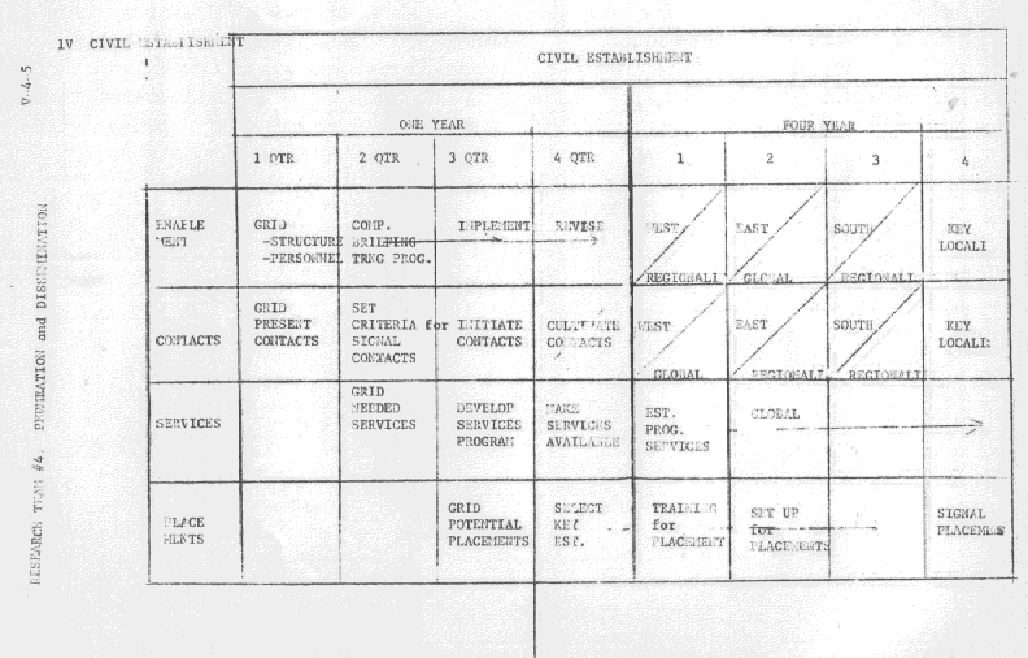
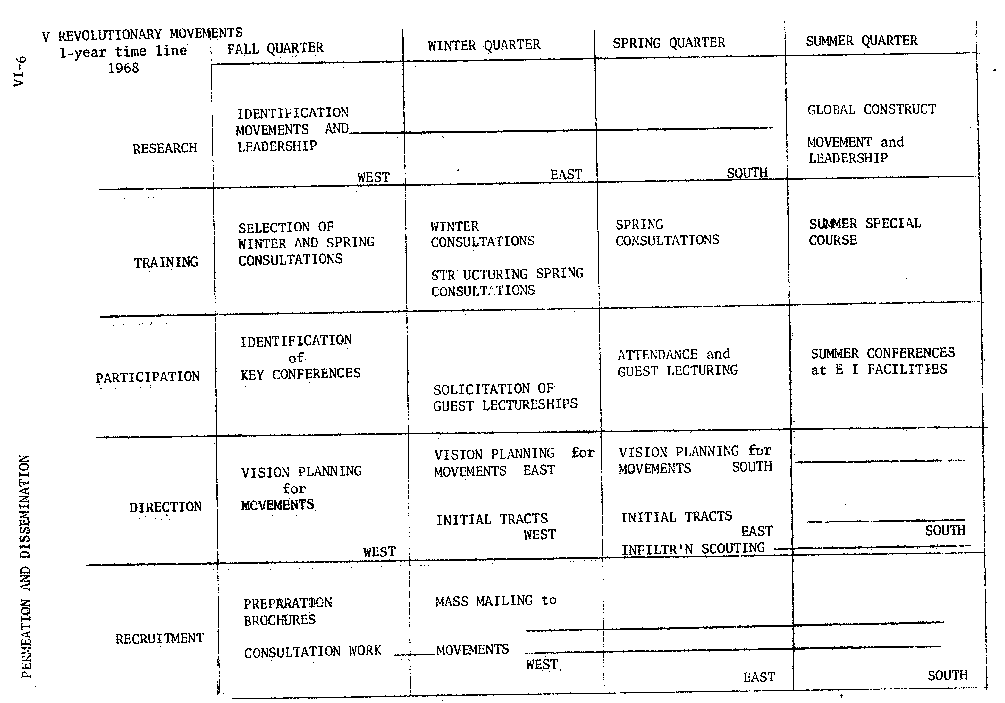
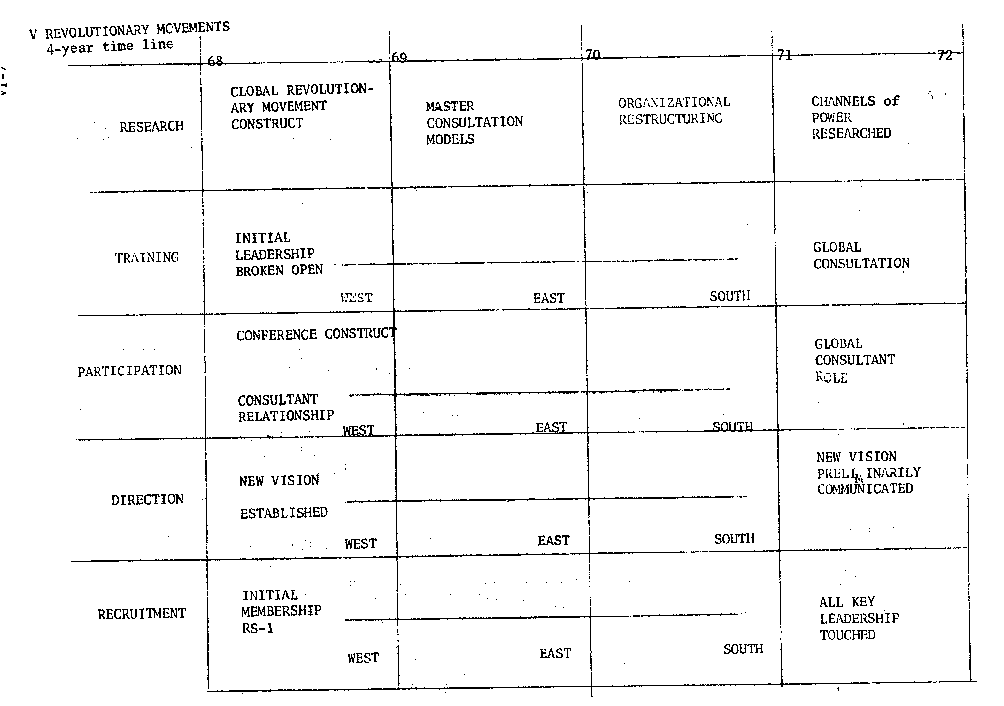
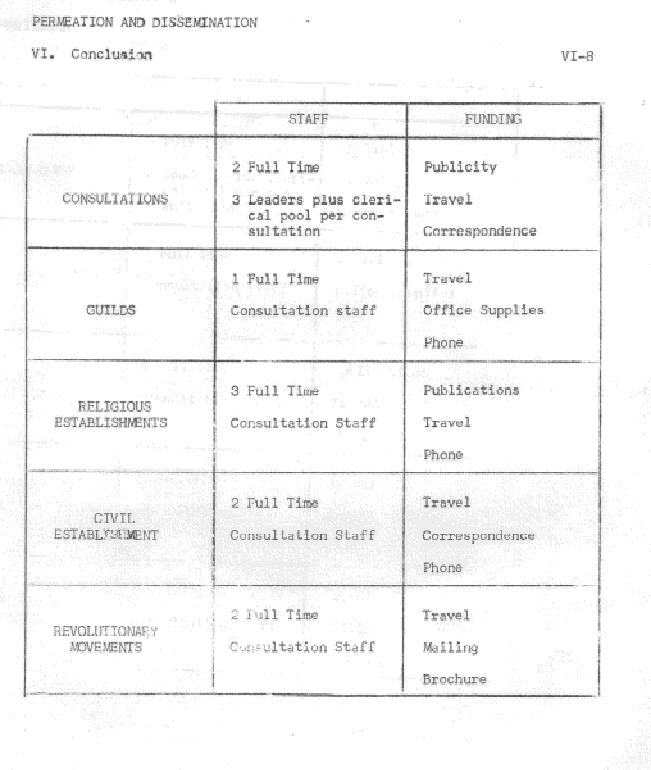 PERMEATION
PERMEATION
VISION:
CHURCH
CRITERIA SPECIFIC
GOALS
PROCESS | The vision of the Spirit Movement sees the Historical Church as the key symbolic institution that celebrates the drama of man's living his life as it is. The Church pushes man up against the mystery of his participation in all cultures. Further, man is seen as both creating and living out of his images. Therefore, the Vision sees the Church both as the inventor and the purveyor of these images. The contradiction within the Church has been its isolation from the real concerns and needs of the community. The demand upon the historical Church is to move from its protected position to one of exposure and engagement with the world. The primary image as "protector of social mores" must be changed to "creator of new human values". This new cosmopolitan image will embody the transformation from narrow parochialism to world citizen dealing `with all basic issues. The vision of the church as the key symbolic institution will be realized through the Signal project of reformulation ecclesiastical structures in three types of denominations Roman Catholic, United Church of Christ, and United Methodist. In order to actualize the global cultus, every local congregation cadre will enable its congregation to develop an ecumenical office. To insure the role of image creator, all ecumenical structures from local councils of churches to national and world bodies will be permeated in order to maintain their diversity within unity. In order to catalyze the global church, "Ur Heritage' courses will be developed for the six Ur areas and conducted in the international program. The process of permeation begins with the decision that it is the total Spirit Movement which will initiate and take responsibility for this direction. Consultations with experts provide a twoway communication so that Spirit Movement insights can be used ir7 institutions from the local through global level whole new insights are fed back into Movement structures. The impacting of structures so that they will be enabled to perform their functions will be done through strategic deployment of Movement resources. Sustenance within permeated structures will be empowered through accountability to the continual demand to be comprehensive and futuric in executing responsibilities. |
| PERMEATION - Political | |
VISION
CRITERIA
GOALS PROCESS | The political base of the New Social Vehicle is the participation of all the people in the decision-making process. The task is to change the present system in which a few decide for many, to one in which all participate in the decision" which affect all. Concretely, the vision of new possibility calls for support of those constructs which proceed from the Formulation models by permeating the existing political establishment at the crucial focal points of power, in order to enable the establishment to hear what the world is saying about the way it is, That is to say, the task is to give the establishment the vision that all of the people do participate in all of life9 enabling the formulation of the new politica1 constructs.
Goals chosen for political permeation need to be those things which are most available for moving the political constructs in the direction of significant decisionmaking on the part of all the people. This happens through the reimaging of people in the political establishment, and of people at the grassroots. Consultation, with political people at the local, regional, national, and global levels can do this, and are practical goals in a time when many lucid politicians see the inevitability of collapse of the present structures. A signal project of permeating at political party metro level, will enable new possibilities for grass roots participation in decision making, and will point the way for a wider network of similar activity in the future. Consultations at the local, regional, national, and global levels to keep abreast of what is going on in all political groups, and to open political persons and groups to spirit movement visions of possibility of necessary new political constructs. Signal project (at the metro or larger level) involving permeation of governing political party in situations where grassroots determination is strong, to enable both governing alliance and grassroots people to gain new images of decision and responsibility by all the people. Research on governing alliances to determine how they work. Study world political revolutions and establish relationships with existing world agencies. The initial demand for the permeation of the political structures is the formation of locale regional, and national guilds to build models, grid movements, and develop curriculum. The second demand is the intensive use of consults at all levels as the means by which the models are introduced into the structures. The third demand is the creation of a national faculty which will distill the accumulated wisdom and thrust it into the Spirit Movement. The final demand is the implementation of a permeation model for the political Signa1 Project which pulls the categories on model building, troop training, and deployment, impact methodologies, and sustainingrelational structures through the circumstances and needs of the area selected. |
| PERMEATION - ECONOMIC | |
VISION
CRITERIA
GOALS PROCESS | The tyranny of the 1Oth and 19th century economic systen9 although still serving as the model for our tines, has completed its valuable function in developing the vast untouched resources of the new world. But the imperative of Century 20 demands that our economic structures serve the function of distributing all the globe's resources equitably among all peoples. It is not necessary to change the basic popular values and understandings relating to this new economic function, for only then will economic distribution patterns be changed. And still further, only by forging a new politicaleconomiccultural dynamic will there emerge the new economic style which will embody and manifest the new social vehicle.
As our present economic system is a manifestation of the style of life of the people of our tines, the Spirit goals, in the context of economics, must begin by dealing directly' or indirectly, at the grassroots level. And if at this level the present image is to be dealt with significantly, the opportunity for a selfconsciousness of style must be thrust at every individual. And further, this thrust rust include the concept of consensus polity in relationship to the new economic style. Finally, a criteria, which arises out of the previous three, must be the imperative to deal with authentic problems in the area of economics.
The strategic goals which must be the concern of the movement in the next four Years are 1) Research in International market trends, 2) one economic guild to be established in each region, 3) Consults on economics with professional groups to reimage our value system and appropriate development of courses and pedagogues and 4) a signal economic project in each region to challenge and explode this value system. To accomplish these goals, appropriate guilds must be gradually established over the next four years. Consults must be recruited for and scheduled and subsequent courses must be developed with pedagogy models built. Models for researching the world economic market must also be constructed. Finally the regional or local criteria for establishing economic signal projects must be decided upon, and actual plans must be made in relation to the circumstances and needs of the area selected. |
PERMEATION -- CULTURAL | |
VISION CRITERIA
FOR GOALS
GOALS PROCESS | Our generation has been born into a radically new world which is utterly scientific urban secular. Every human being on our planet IS being pushed to new depths of self consciousness, driving him to see himself as one who gives shape to the future of the whole civilizing process. The elder in the meet remote barrio sees the necessity of having access to the wisdom of the entire human community. The youth on the most [solaced fern is demanding a new life style that will enable him to live in dynamic relationship to the diverse styles of humanness he meets in the city. The most secular of men is searching for a way to appropriate the symbolic depths of the various creations of humanness across the globe. New vehicles must be created to enable every last human being to participate in the creation of the new global civilization.
The key presupposition underlying the creation of the envisioned global civilization is the pervasive importance of images and symbols in determining the appropriation of humanness. The basic contradiction in the cultural dimension is that the primary images and symbols convey humanness solely in terms of the bourgeois life style and consciousness. Therefore, the permeation of those cultural institutions and structures which are the worldwide image molders and purveyors is the basic strategy of the Spirit Movement in transforming the social vehicle. Because public education and the mass media are the major symbol and inane purveyors which can be practically touched by Spirit Movement resources, they arc the most crucial structures to be influenced in the next four years. As a beginning in the process of transformation of the basic images and bourgeois style out of which the world's masses either live or aspire to9 the permeation of public education and mass media structures is a crucial issue for the Spirit Movement. As a signal, one special productions team of a major TV network must be given the tools and insights which will produce a continuing, monthly series of programs which convey the comprehensive vision of humanness. At the grassroots level the permeation of one public education system, including Board of Education, in each region must be accomplished in the next four years. Nationwide, a signal University operating out of a comprehensive, futuric and intentional vision of education must be raised as a signal to the globe. In order to effect a degree of permeation in the hone, a national magazine shall be permeated to the degree that editorial policy is transformed with a vision of the New Social Vehicle. The immediate task involves the gathering of pertinent data on the TV networks, national nagazine&9 regional public education systems, and Universities by the designated structures of the Spirit Movement. Utilizing model building, grids, and systems analysis techniques, decisions are made on which specific structures are to be permeated and the appropriate movement resources to be deployed. Actual "impact" on the structures w111 involve contacting key personnel within the structure, locating those allies and friends which can be recruited: to consults, specific workshops, courses and other inagina1 explosions in order to open to then the possibilities of global perspectives) in their specialties. If necessary, movement individuals nay temporarily enter the structure to influence a key position or strategically recruit personnel. The presence and style of movement people is an important tool especially in the public education systems and University. Finally, the permeated structures will require a sustaining relationship to movement structures during the transformation period. Such structures as guilds which nay enlist lucid individuals from the permeated systems will provide the continued education and comprehensive vision required. |
